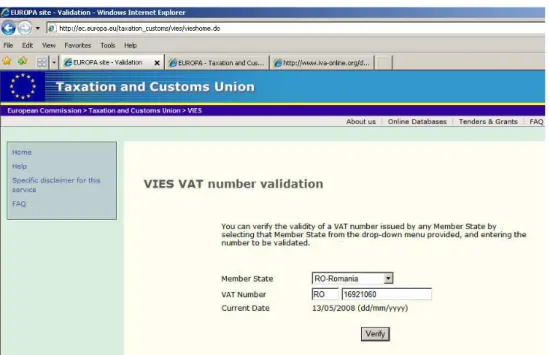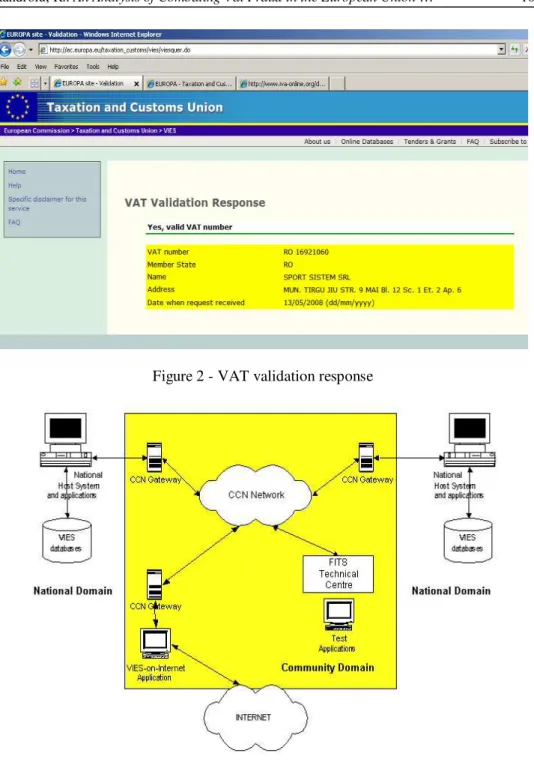Series V: Economic Sciences
AN ANALYSIS OF COMBATING VAT
FRAUD IN THE EUROPEAN UNION
USING NEW IT TECHNOLOGIES
Radu LIX
Ă
NDROIU
1Abstract:European VAT fraud has been growing at an alarming rate [2]. The level of VAT losses for one year is between 60bn and 100bn for all member states. This level of fraud has created an urgent need for Europe to address the issue of the reform of the VAT system.
Key words:IT, VAT, VIES, fraud.
1
Dept. of Management and Economic Informatics, Transilvania University of Bra ov.
Since 1992, VAT fraud has been on a continuous increase. This is due to the fact that businesses have been allowed to trade goods and services across borders without being charged for the tax.
The best known fraud is "the missing trader". This fraud is usually committed by importers of small, high-value goods, who collect VAT from their customers and then disappear without passing the tax on to the government.
The Brussels-based International VAT Association (IVA) states in its report published on 03.06.2007 [1] that Europe's
VAT systems are "hemorrhaging"
revenues as a result of scams based on the black economy, deliberate insolvencies and the so-called "missing trader" fraud, which exploits the zero-rating of goods sold across borders.
The IVA [1] wanted to use the new technology to improve transaction tracking and speed up exchanges of information.
For the purpose of the Directive 2002/38/EC, the services concerned are defined as "electronic services" or "electronically supplied services". The changes in their tax treatment eliminate a
long-standing competitive distortion by ensuring that both non-EU suppliers and EU suppliers are subject to the same VAT rules when they provide electronic services to EU customers.
When a non-EU supplier wants to sell to business customers in the Union (at least 90% of this market), there will be no
change practically and the VAT
implications will be handled by the acquiring company in the EU under self-assessment arrangements.
For the non-EU supplier whose EU customers are non-business individuals or organizations, there will now be an obligation to charge and account for VAT on these sales just as EU suppliers have to.
The most significant new feature introduced by the Directive is the simplified scheme which can be availed of by non-EU operators making B2C supplies into the EU.
This simplified scheme recognizes the unique circumstances of non-established traders providing digital services and provides a fair and efficient means for
these traders to meet their fiscal
Bulletin of the Transilvania University of Bra ov • Vol. 2 (51) - 2009 • Series V 106
For non-resident businesses the
registration aspect of this simplified scheme is easier to operate than the existing rules. The benefit of this scheme is to carry a single point of contact for the entire community, with a set of simplified, harmonized tax obligations.
The data is real-time for VIES (VAT Information Exchange System). For any request, a message is sent to the member state which issued the VAT identification number asking if the number quoted is valid.
The VIES Objective
The objective of the web-site application is to allow persons involved in the
intra-community business to obtain confirmation of the validity of the VAT identification number for any specified person, in accordance with Article 27 of Council Regulation (EC) No. 1798/2003 of 7 October 2003.
The verification is done using the national VAT database corresponding to the member state where the specified person is located. There is no VAT database at community level; there are just national databases in each member state.
The request is directed to the national database via a secure Intranet service which connects national Customs and Taxation administrations, and the reply is sent back soon.
Figure 2 - VAT validation response
Figure 3 - VIES Architecture [6]
Technically, each member state has a national VIES database. The VIES system
Bulletin of the Transilvania University of Bra ov • Vol. 2 (51) - 2009 • Series V 108
Applications in the Community
Domain currently include:
A. VIES Monitoring Applications
(covering the VIES and VIES-on-Web monitoring applications)
B. VIES Statistics Applications (covering
the VIES and VIES-on-Web statistics)
C. VIES Test Application D. VIES Initial Application
E. The VIES-on-Web Application
(covering the interactive and API -
Application Programming Interface
version).
A. VIES Monitoring Applications
allow the Fiscalis Technical Centre to verify the correct operations of the VIES Systems in the national administrations, as well as the VIES-on-Web system in the Directorate-General for Informatics of the Commission.
The VIES Monitoring application
comprises:
•the Monitoring Engine - it sends VIES
requests periodically to each Member State and records the response of these requests in statistical log files
•the Display Module - it reads
information from the statistical log files and graphically displays the current availability of VIES services in the different Member States.
The VIES-on-Web Monitoring
Application was developed by the
Commission. This application is hosted in the Commission by the Directorate-General for Informatics. It consists of two parts:
- A java module sending (configurable) HTTP requests to VIES-on-WEB every 10 minutes
- Shell scripts checking:
1. if the VIES-on-Web processes are running normally;
2. if the processes on the hosting machine are not overloaded
3. the traffic of the current day via the statistical log files.
B. VIES Statistics Applications create
statistics about the traffic on the VIES System and the VIES-on-Web system. The VIES statistics system is used by Fiscalis Technical Centre to produce the monthly statistics for VIES and VIES-on-Web.
The database used for storing the statistics is created in Oracle.
The VIES statistics system uses the following as input to produce the statistics:
1. the daily generated Common
Communications Network / Technical Centre traffic statistics files including the error information in case of errors detected by Common Communications Network/Common System Interface
during the transmission of a
synchronous request submitted with a valid type;
2. the daily generated log files resulting from the VIES monitoring application, which periodically sends preformatted messages to each Member State; 3. the service call data which is available
in the Service Management Tool used by the Fiscalis Technical Centre.
C. The VIES Test Application - Each
D. The VIES Initial Application is a core application that has been updated for B2B services. This application serves as reference for the National Administration. For the VIES Testing Application, each time an extension is required to the VIES System, it should be implemented in the initial application.
E. VIES-On-Web - A particular "client"
was developed and implemented in 2001, the VIES-on-Internet application. Traders visiting the UE web site hosted by the Commission can verify the validity of VAT numbers via "VIES-on-Web". Since November 2005, a VIES-on-Web API has been added to VIES-on-Web, allowing companies and Member State
administrations to check VAT
identification numbers immediately from within an IT system.
An Analysis of VIES Advantages
•The application allows the persons
involved in the intra-community
business to obtain confirmation of the validity of the VAT identification number of any specified person
•The module VIES Statistics Application
creates statistics about the traffic on the VIES System and the VIES-on-Web system.
•Applications can be made at any time –
24 hours a day 7 days a week, until the closing dates.
•This type of application is quick and easy
to create and to implement.
•The system can check for errors.
•There is no risk that the application will
get lost in the post.
•The system has a series of security
procedures which will prevent anyone who seeks information they are not entitled to from doing that.
Disadvantages
•VIES is a web application, and
consequently, each organization needs online access for using it.
•There is no common VAT database at
community level. There are national databases in each member state. This causes many exchanges of information between member states’ databases.
•If one database does not work, the
request cannot be transmitted to other member states.
•A study [8] has revealed that only 81.9%
of Romanian organizations have
computers, and only 64.16% use the
Internet. 27.97% of Romanian
organizations have websites and 7.15% use online shopping.
•For the European Union, a similar study
[7] shows that 85.3% of small
businesses and 95% of medium
businesses own computers. Only 73% of small businesses are connected to the Internet.
References
1. http://www.iva-online.org/ documents/
Bulletin of the Transilvania University of Bra ov • Vol. 2 (51) - 2009 • Series V 110
5. http://ec.europa.eu/taxation_customs/ta
xation/gen_info/info_docs/tax_invento ry/index_en.htm
6. http://ec.europa.eu/taxation_customs/r
esources/documents/common/tenders_
grants/tenders/AO-2007-05/TIMEA_ToR.pdf
7. http://www.mediawebdesign.ro/interne
t.html
8.

